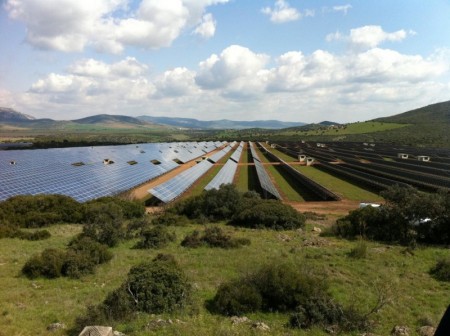Mar
17
3 to 5 Times More Solar Power Than California’s Demand
March 17, 2015 | 2 Comments
Carnegie Institution’s Rebecca R. Hernandez (now at University of California Berkley), Madison K. Hoffacker, and Chris Field found that the amount of energy that could be generated from solar equipment constructed on and around existing infrastructure in California would exceed the state’s demand by up to five times.
The team offers that further development of solar energy is complicated by the need to find space for solar power-generating equipment without significantly altering the surrounding environment.
The team’s work has been published by Nature Climate Change.
Ms. Hernandez explained, “Integrating solar facilities into the urban and suburban environment causes the least amount of land-cover change and the lowest environmental impact.”

Photovoltaic Park Puertollano Spain. Image Credit: Rebecca R. Hernandez. Click image for the largest view.
Just over 8 percent of all of the terrestrial surfaces in California have been developed by people, from cities and buildings to park spaces. Residential and commercial rooftops present plenty of opportunity for power generation through small and utility-scale solar power installations. Other compatible opportunities are available in open urban spaces such as parks.
Likewise, there is opportunity for additional solar construction in undeveloped sites that are not ecologically sensitive or federally protected, such as degraded lands.
“Because of the value of locating solar power-generating operations near roads and existing transmission lines, our tool identifies potentially compatible sites that are not remote, showing that installations do not necessarily have to be located in deserts,” Hernandez said.
This study included the two principle kinds of solar technologies, the photovoltaics, that use semiconductors and are similar to the solar panels found in consumer electronics, and concentrated solar power, which uses enormous curved mirrors to focus the sun’s rays.
A mix of both options would be possible, as best suits each particular area of installation, whether it is on a rooftop, in a park, on degraded lands, or anywhere else deemed compatible or potentially compatible. They found that small and utility-scale solar power could generate up to 15,000 terawatt-hours of energy per year using photovoltaic technology and 6,000 terrawatt-hours of energy per year using concentrating solar power technology.
Overall the team found that California has about 6.7 million acres (27, 286 square kilometers) of land that is compatible for photovoltaic solar construction and about 1.6 million acres (6,274 square kilometers) compatible for concentrating solar power. There is also an additional 13.8 million acres (55,733 square kilometers) that is potentially compatible for photovoltaic solar energy development with minimal environmental impact and 6.7 million acres (27,215 square kilometers) also potentially compatible for concentrating solar power development.
The team’s work shows it is possible to substantially increase the fraction of California’s energy needs met by solar, without converting natural habitat and causing adverse environmental impact and without moving solar installations to locations remote from the consumers.
“As California works to meet requirements that 33 percent of retail electricity be provided by renewable sources by 2020 and that greenhouse-gas emissions be 80 percent below 1990 levels by 2050, our research can help policymakers, developers, and energy stakeholders make informed decisions,” said Field, director of Carnegie’s Department of Global Ecology. “Furthermore, our findings have implications for other states and countries with similarly precious environmental resources and infrastructural constraints.”
Its quite a refreshing review, especially for the green crowd folks. Noticeably absent though, is the financial impact, the storage needed to provide power overnight and cloudy days and the means by which all of this is capitalized.
At the spending pace and the sheer size of the budget for the State of California burning through taxpayers money they would hardly notice the funding of most if not all the responsible fusion projects across the country. If anyone needs fusion to get to commercial breakeven its California taxpayers and ratepayers.
Comments
2 Comments so far


Great. They can build solar panels in all their empty resevoirs. If they need more room they have all that dry farmland that used to feed half the nation.
California enjoys a much better climate for solar power generation than Germany. If Germany, a very heavily industrialized nation, can get 50% of its electrical power from solar then California can easily get more. The cost of solar panels has declined dramatically in the past few years, and recent discoveries, which were reported on this site, promise to make it cheaper still.
The new flow cell batteries, from Germany are becoming a viable way for large scale energy storage for overnight use.
http://www.greentechmedia.com/articles/read/the-german-american-vanadium-flow-battery-connection
Small scale fusion plants are a viable option. Some of the newer designs, do not produce byproducts that may be used for weapons. Unfortunately California has many Earthquake fault lines, and the location for such a plant must be chosen very carefully. Additionally preventive measures must be adequate to handle a large quake, without releasing radiation. This will add extra costs, which the author does not acknowledge. In the past such rosy expectations have led to unfortunate accidents, which the residents of Fukishima Japan know only too well.
Can private energy companies can be trusted to protect the public, at the expense of their own profits? We have seen many examples of private corporations, ignoring regulations, breaching public trust, and evading all responsibility for the resulting damage. From exploding liquid natural gas terminals, to derailed oil trains, incinerating entire towns, and nuclear plants which poison the land for miles, and render it utterly uninhabitable.
Solar power is safer, cleaner, cheaper and more abundant.